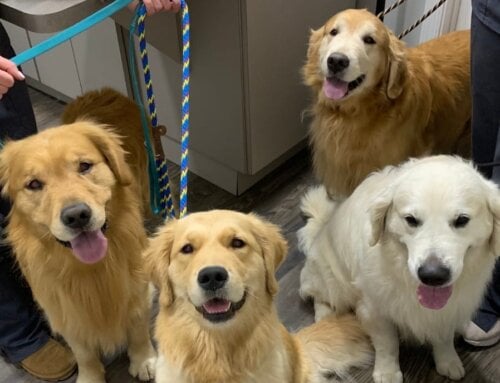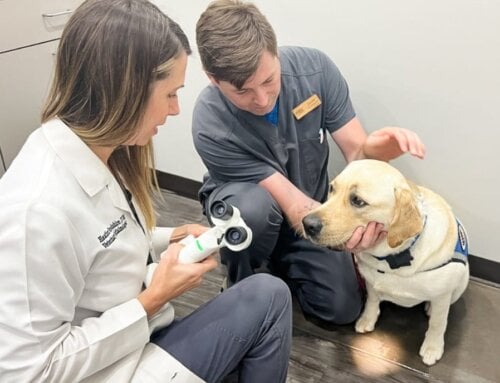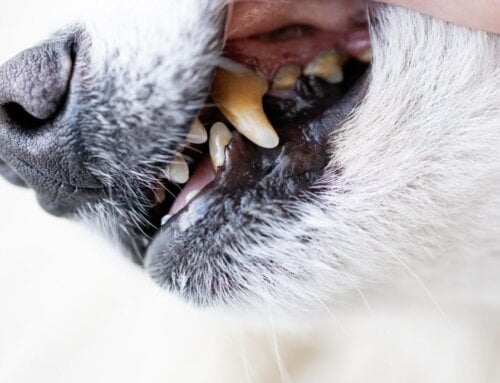Your pet just underwent ophthalmic surgery and has been given an E-collar to wear. It may seem novel or amusing at first, seeing your pet adorned in the “cone of shame.” Soon, clumsiness ensues. Doorjambs, water bowls, even children and the backs of legs get in the way of the collar. Will you and your pet survive? You will. These are normal occurrences, all part of your pet adjusting to this important device. While it may seem funny or frustrating to you at times, having your pet wear the collar (and wear it correctly), will help with your pet’s recovery. It is a necessary short period of “tough love.”
In addition, wearing the E-collar as prescribed will save you money, avoiding the cost of further procedures to repair dislodged sutures. In some cases (especially when cataract or lens luxation surgery is involved), vision-threatening injuries can result if the E-collar is not worn correctly. This could result in decreased vision or removal of the globe.

Short for Elizabethan collar, the funnel-shaped device is named after the ornate ruffs worn by fashionable men, women and children during the Elizabethan era.
To help you and your pet survive the wearing of the collar, here are a few tips to see you through the important recovery time:
 Give your pet time to adjust to the E-collar. While it can restrict your pet’s vision or disorient them somewhat, we can accommodate by providing clear, see-through cones for their use. You can help your pet further by removing items they may bump into at home, such as low tables or decorative objects. Remember, this is only temporary!
Give your pet time to adjust to the E-collar. While it can restrict your pet’s vision or disorient them somewhat, we can accommodate by providing clear, see-through cones for their use. You can help your pet further by removing items they may bump into at home, such as low tables or decorative objects. Remember, this is only temporary!
- Keep an eye on your pet. Watch over them when you are home, confining them to a low-risk, pet-friendly room.
 Supervise them outdoors. It is not safe to let pets wander unsupervised in the yard while wearing the E-collar. For dogs, use a lead for outdoor time and potty break and supervise the break. For cats, we advise keeping them inside at all times when wearing the collar.
Supervise them outdoors. It is not safe to let pets wander unsupervised in the yard while wearing the E-collar. For dogs, use a lead for outdoor time and potty break and supervise the break. For cats, we advise keeping them inside at all times when wearing the collar.
 Do not remove it. If you are tempted to take the E-collar off for a short break, please talk to us first! We can offer solutions for keeping the cone in place. It’s especially important to keep it on 24/7, even at bedtime. While you are sleeping, your pet may be up and about, subconsciously causing damage to their surgery site.
Do not remove it. If you are tempted to take the E-collar off for a short break, please talk to us first! We can offer solutions for keeping the cone in place. It’s especially important to keep it on 24/7, even at bedtime. While you are sleeping, your pet may be up and about, subconsciously causing damage to their surgery site.
-
 Wear the collar as provided; no cutting allowed! The length of the E-collar is just as important as the type of collar. It should extend past the tip of your pet’s nose at all times. If it is not an appropriate length, it won’t provide the adequate level of protection. We will make sure the collar fits your pet properly before you leave our practice. Don’t cut them when you get home.
Wear the collar as provided; no cutting allowed! The length of the E-collar is just as important as the type of collar. It should extend past the tip of your pet’s nose at all times. If it is not an appropriate length, it won’t provide the adequate level of protection. We will make sure the collar fits your pet properly before you leave our practice. Don’t cut them when you get home.
 Do not replace the prescribed collar with another. Inflatable and soft E-collars are effective for general veterinary uses. But they do not protect the eye or ocular area after ophthalmic procedures. With inflatable or soft E-collars, your pet is still able to rub their face on furniture or other objects at home and/or paw at the eye. This can be damaging to a healing procedure, surgical area or ulcer.
Do not replace the prescribed collar with another. Inflatable and soft E-collars are effective for general veterinary uses. But they do not protect the eye or ocular area after ophthalmic procedures. With inflatable or soft E-collars, your pet is still able to rub their face on furniture or other objects at home and/or paw at the eye. This can be damaging to a healing procedure, surgical area or ulcer.
Again, wearing the e-collar is only temporary. Like you, we want your beloved furry family member back to their old tricks ASAP. Keeping the e-collar on helps to ensure this!

Visit our virtual library to learn more about E-Collar Etiquette

 Give your pet time to adjust to the E-collar. While it can restrict your pet’s vision or disorient them somewhat, we can accommodate by providing clear, see-through cones for their use. You can help your pet further by removing items they may bump into at home, such as low tables or decorative objects. Remember, this is only temporary!
Give your pet time to adjust to the E-collar. While it can restrict your pet’s vision or disorient them somewhat, we can accommodate by providing clear, see-through cones for their use. You can help your pet further by removing items they may bump into at home, such as low tables or decorative objects. Remember, this is only temporary! Supervise them outdoors. It is not safe to let pets wander unsupervised in the yard while wearing the E-collar. For dogs, use a lead for outdoor time and potty break and supervise the break. For cats, we advise keeping them inside at all times when wearing the collar.
Supervise them outdoors. It is not safe to let pets wander unsupervised in the yard while wearing the E-collar. For dogs, use a lead for outdoor time and potty break and supervise the break. For cats, we advise keeping them inside at all times when wearing the collar. Do not remove it. If you are tempted to take the E-collar off for a short break, please talk to us first! We can offer solutions for keeping the cone in place. It’s especially important to keep it on 24/7, even at bedtime. While you are sleeping, your pet may be up and about, subconsciously causing damage to their surgery site.
Do not remove it. If you are tempted to take the E-collar off for a short break, please talk to us first! We can offer solutions for keeping the cone in place. It’s especially important to keep it on 24/7, even at bedtime. While you are sleeping, your pet may be up and about, subconsciously causing damage to their surgery site. Wear the collar as provided; no cutting allowed! The length of the E-collar is just as important as the type of collar. It should extend past the tip of your pet’s nose at all times. If it is not an appropriate length, it won’t provide the adequate level of protection. We will make sure the collar fits your pet properly before you leave our practice. Don’t cut them when you get home.
Wear the collar as provided; no cutting allowed! The length of the E-collar is just as important as the type of collar. It should extend past the tip of your pet’s nose at all times. If it is not an appropriate length, it won’t provide the adequate level of protection. We will make sure the collar fits your pet properly before you leave our practice. Don’t cut them when you get home. Do not replace the prescribed collar with another. Inflatable and soft E-collars are effective for general veterinary uses. But they do not protect the eye or ocular area after ophthalmic procedures. With inflatable or soft E-collars, your pet is still able to rub their face on furniture or other objects at home and/or paw at the eye. This can be damaging to a healing procedure, surgical area or ulcer.
Do not replace the prescribed collar with another. Inflatable and soft E-collars are effective for general veterinary uses. But they do not protect the eye or ocular area after ophthalmic procedures. With inflatable or soft E-collars, your pet is still able to rub their face on furniture or other objects at home and/or paw at the eye. This can be damaging to a healing procedure, surgical area or ulcer.














